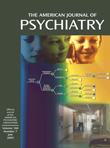To the Editor: In our article, we argued that low orientation to salient social cues embedded in naturalistic social situations is a core deficit in autism. We argued this on the basis of several observations that are not consistent with the suggestions made by Drs. Kemner and van Engeland. Their hypothesis is that individuals with autism exhibit abnormalities in processing moving (versus static) stimuli in general and that the conflict between their findings (van der Geest et al., 2002; J Autism Dev Disord; van der Geest et al., 2002; J Child Psychol Psychiatry) and our results in the
Journal and elsewhere
(1) could be explained in terms of their use of static faces and our use of moving faces.
However, in our experiments, there were several situations in which individuals with autism visually tracked, inspected, and reacted appropriately to moving objects (e.g., a moving glass held by one of the movie protagonists, an opening door, a swinging lamp) as well as movement cues. Figure 6 in our article (p. 903) actually shows that a person with autism reacted more quickly than a typical viewer to a moving cue and with equal accuracy. On the basis of our observations, the scanning patterns of a typical viewer were not different from those of a viewer with autism in their general response to moving stimuli; rather, they differed in specific response to the social components of the stimuli, as opposed to the nonsocial physical aspects (whether static or not). In fact, there were situations in which a face was stationary for as long as 15 seconds and yet the fixation patterns exhibited by the viewer with autism still revealed a preference for the mouth area rather than the facial area (as in Figure 3, p. 900). Although not included in this article, of the time that the viewer with autism looked at faces, he or she spent 14.2% on the eye area and 85.8% on the mouth area, contrasted with 77.8% and 22.2%, respectively, for the typical viewer (χ
2=8.77, df=1, p=0.003). This greater fixation time for mouths was further corroborated in our case-control series
(1). Among the various elements of the face, when people are talking the mouth is probably the one that moves the most. In light of this, it is unclear how focus on the mouth, as described in the letter by Drs. Kemner and van Engeland, could reflect an effort by viewers with autism “to overcome a basic perceptual problem,” defined as difficulty in processing moving objects.
Finally, we disagree with the suggestion implied in their letter that lack of abnormality in visual fixation patterns in response to static faces signifies intact brain function (involving the lateral fusiform gyrus) underlying “structural facial processing.” We
(2) and others
(3) have shown that intact performance in facial recognition tasks may in fact be associated with abnormal activation patterns of the ventral temporal cortices (specifically, hypoactivation of the fusiform facial area).
In our view, the conflicting findings across the two studies reflect a different but important conceptual point
(4). The difference between the studies is that while van der Geest and colleagues presented their subjects with static pictures of faces occupying the entire viewing area, we presented our subjects with scenes intended to recreate a more naturalistic social situation, in which people’s faces were embedded in a changing, ongoing context (just as we see people day to day in a way that is necessarily dynamic). While we may encounter static depictions of faces in a magazine, our daily social interactions are inherently contextual and dynamic. In our view, this dynamism is not so much an experimental confound as an integral component of real social scenarios. The main hypothesis put forward in our article was not that individuals with autism are unable to scan faces adequately if instructed to look carefully at them. Our main hypothesis was that they fail to do so in more naturalistic situations when they are trying to make sense of what they see as it is happening. It is in this sense that eye-tracking methods allow us to identify spontaneous visual fixation patterns displayed by individuals with autism, presenting a window into those aspects of the social scene that may have been missed as well as a better understanding of the possible compensatory strategies used to detect meaning in what they see.

